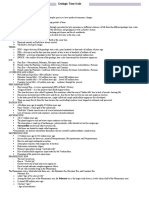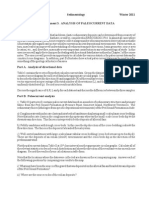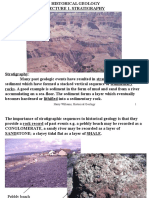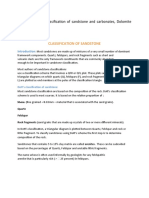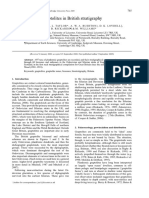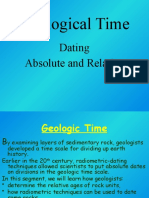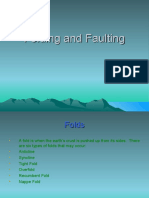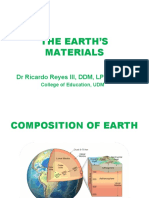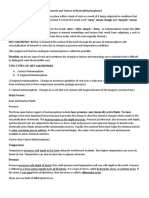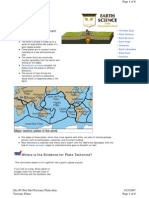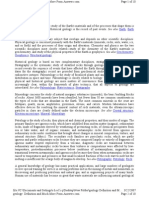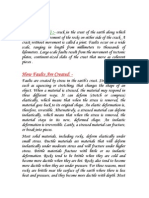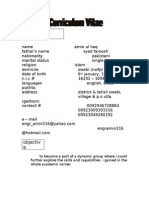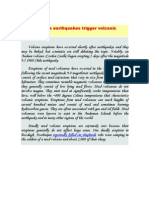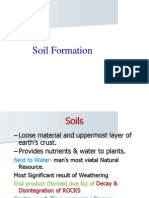Weathering Sedimentary Rocks
Weathering Sedimentary Rocks
Uploaded by
api-3808551Copyright:
Available Formats
Weathering Sedimentary Rocks
Weathering Sedimentary Rocks
Uploaded by
api-3808551Copyright
Available Formats
Share this document
Did you find this document useful?
Is this content inappropriate?
Copyright:
Available Formats
Weathering Sedimentary Rocks
Weathering Sedimentary Rocks
Uploaded by
api-3808551Copyright:
Available Formats
WEATHERING/SEDIMENTARY ROCKS Page 1 of 10
WEATHERING AND SEDIMENTARY ROCKS
Weathering - Process which acts at the earth's surface to decompose and breakdown rocks.
Erosion - The movement of weathered material from the site of weathering. Primary agent is
gravity, but gravity acts in concert with running water.
Types of Weathering
1. Mechanical or Physical - the breakdown of rock material into smaller and smaller pieces
with no change in the chemical composition of the weathered material.
2. Chemical - the breakdown of rocks by chemical agents. Obviously the chief chemical
agent is water which carries dissociated carbonic acid.
Mechanical Weathering
1. Expansion and Contraction - the thermal heating and cooling of rocks causing
expansion and contraction.
2. Frost Action - Water freezes at night and expands because the solid occupies greater
volume. Action wedges the rocks apart. Requires adequate supply of moisture; moisture
must be able to enter rock or soil; and temperature must move back and forth over
freezing point.
3. Exfoliation - process in which curved plates of rock are stripped from a larger rock
mass. Example Half Dome. Exact mechanism uncertain but probably due to unloading.
4. Other types - Cracking of rocks by plant roots and burrowing animals.
Chemical Weathering
Factors which effect the rate of chemical weathering are:
Particle size - Smaller the particle size the greater the surface area and hence the more
rapid the weathering
Composition
Climate (See Figure)
Type and amount of vegetation
file://C:\Documents and Settings\s h a f i q\Desktop\WEATHERING-SEDIMENTARY R... 3/23/2007
WEATHERING/SEDIMENTARY ROCKS Page 2 of 10
Chemical Weathering of Rocks
Show Figure and explain formation of carbonic acid
H2O + CO2 ------->> H2CO3
Acid then dissociates and the following happens:
2KAlSi3O8 (feldspar)+ 2H+ + H2O ------->> Al2Si2O5(OH)4 (clay)+ 2K+ + 4SiO2
file://C:\Documents and Settings\s h a f i q\Desktop\WEATHERING-SEDIMENTARY R... 3/23/2007
WEATHERING/SEDIMENTARY ROCKS Page 3 of 10
Weathering of Igneous Minerals
Products of Weathering Figure:
1. Quartz - slow process and largely ineffective. Quartz remains quartz. Grains are
rounded.
2. Feldspar - weathers to clay with the cations Na, Ca, and K going into solution. Clays that
can form include kaolinite (pure aluminum silicate), illite and montmorillonite. Factors
which dictate clay formation are (a) climate; (b) time; (c) parent material.
3. Muscovite - Same as above
4. Ferromagnesian minerals - weather to clay plus highly insoluble iron oxides, essentially
varieties of limonite (rust).
Rates of Weathering
Studied by S.S. Goldich (Figure) and found to be inverse of Bowen's Reaction Series. Why? A
function of equilibrium, the higher the temperature of formation of a mineral the more unstable
it is at the earth's surface. Hence olivine weathers the most rapidly.
file://C:\Documents and Settings\s h a f i q\Desktop\WEATHERING-SEDIMENTARY R... 3/23/2007
WEATHERING/SEDIMENTARY ROCKS Page 4 of 10
Soils
Soil - Surficial material that forms due to weathering. Includes an organic component. Many
different soil types. Factors effecting their formation are:
1) Climate
2) Relief
3) Bedrock material
4) Time
Classification of soils varies depending on the classifier. Geologists use a very simple
classification based largely on materials added or removed from the soil during its formation.
Soil consists of four major zones (horizons) (Figure).
1. O horizon - Organic layer
2. A horizon - Zone of leaching - Cations
are leached from this horizon by strongly
acid solutions generated in the O horizon
3. B horizon - Zone of Accumulation -
Cations leached out of the A horizon
accumulate here. Horizon consists of clays,
iron and aluminum oxides. Deposition due
to neutralization of acid solutions.
4. C horizon - Partially decomposed parent
material. Lower most zone.
file://C:\Documents and Settings\s h a f i q\Desktop\WEATHERING-SEDIMENTARY R... 3/23/2007
WEATHERING/SEDIMENTARY ROCKS Page 5 of 10
Soil Types
Pedalfer - Named for the abundance of Al and Fe in the B horizon. Occur in temperate, humid
climates. Lie generally east of the Mississippi River, correspond with 63 cm/yr rainfall contour.
Pedocal - Named for the accumulation of calcium carbonate in the B horizon. Characteristic of
temperate, dry climates. Lie generally west of Miss River. Poorly developed A horizon, B
horizon is caliche (calcium carbonate).
Laterites - Tropical soils thought to represent the end products of weathering. Characterized
by stark red color and abundance of iron and aluminum oxides and lesser clay minerals.
Requires abundant rainfall.
SEDIMENTARY ROCKS
Sedimentary Rocks - Layered or stratified rocks formed at or near the earth's surface in
response to the processes of weathering, erosion, transportation and deposition.
Rock Cycle
All rocks discussed in this class are a part of the rock cycle (Figure).
Sedimentary Cycle (Figure)
Processes
file://C:\Documents and Settings\s h a f i q\Desktop\WEATHERING-SEDIMENTARY R... 3/23/2007
WEATHERING/SEDIMENTARY ROCKS Page 6 of 10
1. Transportation - Transporting medium usually water. More rarely wind or glacial ice.
2. Deposition - Occurs when energy necessary to transport particles is no longer available.
Deposition due to the gentle settling of mineral grains. Can also be result of chemical
precipitation due to changing conditions.
3. Lithification - Involves several steps. All taken together are termed Diagenesis.
a. Compaction - Squeezing out of water.
b. Cementation - Precipitation of chemical cement from trapped water and circulating
water.
c. Recrystallization - Growth of grains in response to new equilibrium conditions
Single most important characteristic of sedimentary rocks is layering. Occurs in response to
changes in conditions at the site of deposition. Sedimentary rocks cover 75% of the earth's
surface, but amount to only 5% of the outer 10 km.
Origin of Sedimentary Material
Derived directly from pre-existing rocks. Ex. quartz.
Derived from weathered products of these rocks. Ex. clay.
Produced by chemical precipitation. Ex. calcite.
First two processes result in detrital or clastic rocks. Third produces nondetrital or chemical
sedimentary rocks.
Minerals of Sedimentary Rocks
1. Clay - Important constituent of mudstones and shales, but occurs in minor amounts in all
sedimentary rocks.
2. Quartz - Most abundant constituent of sandstone. In addition to detrital quartz, free silica
can be chemically precipitated as opal, chalcedony and chert.
3. Calcite - Chief constituent of limestone. Precipitates from seawater which is saturated in
both Ca+2 and CO3-2. Small changes in both T and P enough to cause precipitation.
Differs from most compounds in that solubility decreases with increasing temperature.
4. Others
a. Dolomite CaMg(CO3)2 - Most important constituent of dolostone
b. Feldspars - Occur in sedimentary rocks formed by very quick deposition and burial
allowing no time for feldspars to alter to clay.
file://C:\Documents and Settings\s h a f i q\Desktop\WEATHERING-SEDIMENTARY R... 3/23/2007
WEATHERING/SEDIMENTARY ROCKS Page 7 of 10
c. Iron oxides and sulfides - Chemical precipitates dictated by the environment at the
site of deposition.
d. Salts and gypsum - Chemical precipitates occurring in restricted sedimentary
basins under arid climatic conditions. Modern analog is the Middle East (Red Sea).
e. Volcanic Debris - Glass and other pyroclastic material incorporated into sediments.
5. Organic Material - Forms coal and gives color to black shales.
Classification of Sedimentary Rocks
Texture - Size, shape and arrangement of particles.
1. Clastic - Formed from broken or fragmented grains (detrital). Rock appears grainy.
Basis of classification of the clastic rocks is the Wentworth Size Scale which was derived
from studies of grain diameters.
Wentworth Size Scale
Boulder >256 mm Conglomerate
Cobble 64-256 mm
Pebble 2-64 mm
Sand 1/16-2 mm Sandstone
Silt 1/256-1/16 mm Siltstone
Clay <1/256 mm Shale
Conglomerate - Detrital rock made up of more or less rounded fragments, an appreciable
percentage of which are pebble size or larger
Sandstone - Consists primarily of grains in the sand size range. Dominant mineral in
sandstones is always quartz. Further subdivide sandstones based on other minerals present.
Quartz sandstone is 99% quartz. Arkose contains both quartz and feldspar. Graywacke is a
garbage sandstone with quartz, feldspar, mica and rock fragments. Often has a significant
fine-grained component and is poorly sorted.
Siltstone - Rare sedimentary rock composed mostly of silt sized particles. Rare because
dominant mineral is quartz which does not like to get any smaller than sand size. Many
siltstones thought to form by glacial grinding of sand-sized quartz grains.
Shale - Most common of the sedimentary rocks. Composed primarily of clay minerals. Often
tends to split into flat sheets due to the mica-like cleavage of clay minerals.
file://C:\Documents and Settings\s h a f i q\Desktop\WEATHERING-SEDIMENTARY R... 3/23/2007
WEATHERING/SEDIMENTARY ROCKS Page 8 of 10
2. Nonclastic (chemical) - Grains are interlocked through crystallization. Has igneous
appearing texture with very little open space.
Limestone - Formed by the precipitation of calcite from seawater. Most form in marine
environments, but also around hot springs, as a crust in desert soils, and as cave formation.
Dolostone - Composed of the mineral dolomite. Probably starts life as limestone then is altered
to dolostone by Mg-bearing solutions in arid environments.
Evaporites - Formed by partial to complete evaporation of seawater in enclosed basins. Forms
salts and gypsum.
Organic Rocks - Rocks formed by the accumulation of organic material. Ex. coquina and chalk.
Coal - Rock composed of lithified plant material.
Abundance of Sedimentary Rocks (Figure)
Sedimentary Structures (Figure)
file://C:\Documents and Settings\s h a f i q\Desktop\WEATHERING-SEDIMENTARY R... 3/23/2007
WEATHERING/SEDIMENTARY ROCKS Page 9 of 10
A) Structures formed during deposition
1. Bedding - Layering of sedimentary rocks. Each bed represents a homogeneous set of
conditions of sedimentation. New beds indicate new conditions. Most layering is parallel,
but occasionally it is inclined. These inclined layers are cross beds. Examples of
sedimentary environments in which cross beds form are dune fields and deltas.
2. Graded beds occur when a mass of sediment is deposited rapidly. The bedding has the
coarsest sediment at the bottom and finest at the top. Often found forming in submarine
canyons. A collection of graded beds is termed a turbidite deposit. Well exposed in many
of the sea cliffs along So. Cal. beaches.
3. Ripple Marks - Waves of sand often seen on a beach at low tide and in stream beds.
a) Current - asymmetrical - Rivers
b) Oscillation - symmetrical - Beaches
4. Mud Cracks - Polygonal-shaped cracks which develop in fine grained sediments as they
dry out. Common in arid environments, such as a desert.
B) Structures formed after deposition
1. Nodule - Irregular, ovoid concentration of mineral matter that differs in composition from
the surrounding sedimentary rock. Long axis of the nodule usually parallels the bedding
plane and seems to prefer certain layers.
file://C:\Documents and Settings\s h a f i q\Desktop\WEATHERING-SEDIMENTARY R... 3/23/2007
WEATHERING/SEDIMENTARY ROCKS Page 10 of 10
2. Concretion - Local concentration of cementing material. Generally round. Usually consist
of calcite, iron oxide or silica. Can exceed 1 meter in diameter. Not understood how they
form.
3. Geode - Roughly spherical structures up to 30 cm in diameter. Outer layer consists of
chalcedony. Inside lined with crystals. Calcite and quartz the most common.
C) Other features
1. Fossils - Any direct evidence of past life. Examples are dinosaur bones, shells of marine
organisms, plant impressions, etc.
file://C:\Documents and Settings\s h a f i q\Desktop\WEATHERING-SEDIMENTARY R... 3/23/2007
You might also like
- (1975 Berg) Capillary Pressures in Stratigraphic TrapsDocument18 pages(1975 Berg) Capillary Pressures in Stratigraphic TrapsAiwarikiaarNo ratings yet
- Formation of Sedimentary RocksDocument12 pagesFormation of Sedimentary RocksBalqis yasin100% (1)
- Ch5 Sediments and Sedimentary RocksDocument64 pagesCh5 Sediments and Sedimentary RocksamirNo ratings yet
- Stromatolites Existed and Other Bacterial CellsDocument3 pagesStromatolites Existed and Other Bacterial CellsRheena FelicianoNo ratings yet
- How To Make A Thin SectionDocument16 pagesHow To Make A Thin SectionM Arif HidayatullahNo ratings yet
- Anatomy of A Subduction ZoneDocument1 pageAnatomy of A Subduction ZonecvytasekNo ratings yet
- Analysis of Paleocurrent DataDocument6 pagesAnalysis of Paleocurrent Dataugcc_sr0112No ratings yet
- Mass WastingDocument64 pagesMass WastingEkala XuhalxNo ratings yet
- Primary, Secondary and Tertiary Migrations in The Accumulation of Petroleum and Their DifferencesDocument5 pagesPrimary, Secondary and Tertiary Migrations in The Accumulation of Petroleum and Their DifferencesSummer SepnioNo ratings yet
- Contact Metamorphic Rocks-BGSDocument28 pagesContact Metamorphic Rocks-BGSYesBoss11100% (1)
- Earth Hist 1Document62 pagesEarth Hist 1Vicky SinghNo ratings yet
- BRAC University: Lecture 8: Environmental Resources: Soil and AgricultureDocument26 pagesBRAC University: Lecture 8: Environmental Resources: Soil and AgricultureMu Sh FiqNo ratings yet
- England 1987 Petroleum MigrationDocument21 pagesEngland 1987 Petroleum MigrationMunish KohliNo ratings yet
- BSEM Reviewer - GeologyDocument25 pagesBSEM Reviewer - GeologyLoue PayangdoNo ratings yet
- Mathematic in GeologyDocument9 pagesMathematic in GeologyR.A. Muhammed HajaniNo ratings yet
- Concentrations and SolutionsDocument8 pagesConcentrations and SolutionsSunnyNo ratings yet
- StratigrafiDocument22 pagesStratigrafiAdityaMangalaNo ratings yet
- 3 - Modern Atomic TheoryDocument28 pages3 - Modern Atomic Theorysalvador.xyriesyuan.g7peaceNo ratings yet
- EPS 50 Lab 4: Sedimentary Rocks: Grotzinger and Jordan, Chapter 5Document7 pagesEPS 50 Lab 4: Sedimentary Rocks: Grotzinger and Jordan, Chapter 5Abood BuriahiNo ratings yet
- Classification of Sandstone and Carbonates, Dolomite and Dolomitization)Document7 pagesClassification of Sandstone and Carbonates, Dolomite and Dolomitization)Tushar NaikNo ratings yet
- Aquatic Ecosystem and TypesDocument2 pagesAquatic Ecosystem and TypesGlorylourd Joana FulloNo ratings yet
- Yielding Et Al. - 2010 - Fault Seal Calibration A Brief Review PDFDocument13 pagesYielding Et Al. - 2010 - Fault Seal Calibration A Brief Review PDFpuka2427No ratings yet
- Graptolites in British StratigraphyDocument66 pagesGraptolites in British StratigraphyAbel Ramirez AmpueroNo ratings yet
- Geolab 2 Ch1Document22 pagesGeolab 2 Ch1freeloader9990% (1)
- Depositional Sedimentary EnvironmentsDocument2 pagesDepositional Sedimentary EnvironmentssergonzalezNo ratings yet
- Cloud Formation ProcessesDocument7 pagesCloud Formation ProcessesSachin SrivastavaNo ratings yet
- 6 - Metamorphic RocksDocument50 pages6 - Metamorphic Rocksloralara100% (1)
- R. Criss - Stable Isotope Distribution (Geological) (Short Article) (1995)Document16 pagesR. Criss - Stable Isotope Distribution (Geological) (Short Article) (1995)lina jimenezNo ratings yet
- The Climate System: An Overview: Co-Ordinating Lead AuthorDocument14 pagesThe Climate System: An Overview: Co-Ordinating Lead AuthorAlina SurubaruNo ratings yet
- Geologic Time ScaleDocument5 pagesGeologic Time ScaleAbdur RehmanNo ratings yet
- Retrospective of 70 Years o F Organic Geochemistry 2005 KvenvoldenDocument11 pagesRetrospective of 70 Years o F Organic Geochemistry 2005 KvenvoldenMario GarciaNo ratings yet
- Geology and Geophysics: PrerequisitesDocument7 pagesGeology and Geophysics: Prerequisitesdonna_marie_7No ratings yet
- Geology Syllabus PDFDocument2 pagesGeology Syllabus PDFChristian GomezNo ratings yet
- Chapter 6A - Capillary PressureDocument31 pagesChapter 6A - Capillary PressurePlumblineNo ratings yet
- Cloud Formation PDFDocument7 pagesCloud Formation PDFAdonis100% (1)
- 2015-2016 EARTHS Dating MethodsDocument37 pages2015-2016 EARTHS Dating MethodsasdNo ratings yet
- Derivation of The Diffusivity EquationDocument18 pagesDerivation of The Diffusivity EquationImranul Haque NoorNo ratings yet
- Organic Geochemical Characterization of Bitumens, Seeps, RockDocument13 pagesOrganic Geochemical Characterization of Bitumens, Seeps, Rockahmed1581973No ratings yet
- Abrams 2005 Significance of Hydrocarbon Seepage Relative To Petroleum GenerationDocument21 pagesAbrams 2005 Significance of Hydrocarbon Seepage Relative To Petroleum GenerationGary PateNo ratings yet
- Mineralogy and Optical Mineralogy: Lab Manual Compiled by Brittani D. Mcnamee and Mickey E. GunterDocument51 pagesMineralogy and Optical Mineralogy: Lab Manual Compiled by Brittani D. Mcnamee and Mickey E. GunterKlaus KauffmannNo ratings yet
- (1987 England Et Al.) The Movement and Entrapement of Petroleum Fluids in The SubsurfaceDocument21 pages(1987 England Et Al.) The Movement and Entrapement of Petroleum Fluids in The SubsurfaceAiwarikiaarNo ratings yet
- Mikropal Prep TechniqueDocument32 pagesMikropal Prep TechniqueMichelle CalistaNo ratings yet
- AsphaltDocument14 pagesAsphaltAli AyanNo ratings yet
- Amplitude Versus Offset - Wikipedia, The Free EncyclopediaDocument6 pagesAmplitude Versus Offset - Wikipedia, The Free Encyclopediamosco_scridbNo ratings yet
- Folding and FaultingDocument16 pagesFolding and FaultingDeepesh KhandelwalNo ratings yet
- The Earth'S Materials: DR Ricardo Reyes III, DDM, LPT, MAEDDocument58 pagesThe Earth'S Materials: DR Ricardo Reyes III, DDM, LPT, MAEDAlessandra MallariNo ratings yet
- Mesozoic LifeDocument20 pagesMesozoic Lifetehreem iftikharNo ratings yet
- Migration Pathways of HydrocarbonDocument6 pagesMigration Pathways of HydrocarbonPetrus AdityaNo ratings yet
- 2003 Book Chapter 9 Biomarkers AnalyticalbookDocument24 pages2003 Book Chapter 9 Biomarkers AnalyticalbookmarinarebackNo ratings yet
- Age and Origin of The EarthDocument22 pagesAge and Origin of The Earthapi-193311681No ratings yet
- Quantitative Geometry of Thrust and Fold Belt StructuresDocument28 pagesQuantitative Geometry of Thrust and Fold Belt StructuresIrfan BaigNo ratings yet
- G11 Earth ScienceDocument14 pagesG11 Earth ScienceAlthea RivadeloNo ratings yet
- Precipitation. Module 2: Lesson 1. Formation of PrecipitationDocument28 pagesPrecipitation. Module 2: Lesson 1. Formation of PrecipitationDean Albert ArnejoNo ratings yet
- Igneous Rocks and Volcanoes LabDocument6 pagesIgneous Rocks and Volcanoes LabGil GameshNo ratings yet
- Surface Geochemical ExplorationDocument27 pagesSurface Geochemical Explorationplatinumjunk100% (2)
- Weathering and Sedimentary RocksDocument35 pagesWeathering and Sedimentary RocksAsLamNo ratings yet
- WEATHERINGDocument17 pagesWEATHERINGOfosu AnimNo ratings yet
- Section 6-Soil Formation and DevelopmentDocument67 pagesSection 6-Soil Formation and DevelopmentMyx MagulladoNo ratings yet
- Geology 11 - Lecture Notes 2Document18 pagesGeology 11 - Lecture Notes 2Mars Onairis0% (1)
- Rock Cycle and Rock Cycle AnswersDocument4 pagesRock Cycle and Rock Cycle Answersapi-3808551100% (2)
- Tectonic PlatesDocument6 pagesTectonic Platesapi-3808551No ratings yet
- CV BilalDocument2 pagesCV Bilalapi-3808551No ratings yet
- ArshadDocument1 pageArshadapi-3808551No ratings yet
- Personal CV ShafiqDocument2 pagesPersonal CV Shafiqapi-3808551No ratings yet
- Bio Data and CV - ShafiqDocument1 pageBio Data and CV - Shafiqapi-3808551No ratings yet
- MineralsDocument3 pagesMineralsapi-3808551No ratings yet
- Introduction To Historical GeologyDocument5 pagesIntroduction To Historical Geologyapi-38085510% (1)
- Class 1 Overview of Physical GeologyDocument5 pagesClass 1 Overview of Physical Geologyapi-3808551No ratings yet
- Geology Definition and Much More From Answers - ComDocument10 pagesGeology Definition and Much More From Answers - Comapi-3808551No ratings yet
- MagmaDocument4 pagesMagmaapi-3808551No ratings yet
- Earthquakes & Earth's InteriorDocument14 pagesEarthquakes & Earth's Interiorapi-3808551No ratings yet
- The University of Melbourne - MineralsDocument13 pagesThe University of Melbourne - Mineralsapi-3808551No ratings yet
- FaultDocument5 pagesFaultapi-3808551100% (1)
- Ore - Wikipedia, The Free EncyclopediaDocument2 pagesOre - Wikipedia, The Free Encyclopediaapi-3808551No ratings yet
- Earthquake Questions and Answers: What Is An Earthquake?Document15 pagesEarthquake Questions and Answers: What Is An Earthquake?api-3808551No ratings yet
- The Structure of The EarthDocument3 pagesThe Structure of The Earthapi-3808551No ratings yet
- ArshadDocument1 pageArshadapi-3808551No ratings yet
- My New Latest CVDocument1 pageMy New Latest CVapi-3808551100% (1)
- FaultDocument5 pagesFaultapi-3808551100% (1)
- Igneous Rock TexturesDocument5 pagesIgneous Rock Texturesapi-3808551No ratings yet
- Geology DifinitionsDocument2 pagesGeology Difinitionsapi-3808551No ratings yet
- The Birth of A GlacierDocument1 pageThe Birth of A Glacierapi-3808551No ratings yet
- TOPTENDocument4 pagesTOPTENapi-3808551No ratings yet
- Hollow Earth DiagramDocument1 pageHollow Earth Diagramapi-3808551No ratings yet
- Amin CVDocument5 pagesAmin CVapi-3808551100% (1)
- Can Earthquakes Trigger Volcanic Eruptions ! - VolcanoDocument1 pageCan Earthquakes Trigger Volcanic Eruptions ! - Volcanoapi-3808551No ratings yet
- Soil Pollution: Dr. M. Prabhu InbarajDocument17 pagesSoil Pollution: Dr. M. Prabhu InbarajSouradeep GuptaNo ratings yet
- Origin of Soils and Grain SizeDocument31 pagesOrigin of Soils and Grain Sizezaima maghfirohNo ratings yet
- Haramaya University - Summer 2011Document4 pagesHaramaya University - Summer 2011aakuma100% (2)
- SSURGO Metadata Tables and Columns ReportDocument87 pagesSSURGO Metadata Tables and Columns ReportMonowarSaikatNo ratings yet
- Macedo, Et Al (2017) Pedogenetic Processes in Anthrosols With PDFDocument19 pagesMacedo, Et Al (2017) Pedogenetic Processes in Anthrosols With PDFkellybrandNo ratings yet
- Tigray Appendix c1 SoilsDocument17 pagesTigray Appendix c1 SoilsTilahun TolosaNo ratings yet
- Soil Science GlossaryDocument93 pagesSoil Science GlossaryShima Tan100% (1)
- Field Manual For Soil Type Identification: Soil Fertility Evaluation/Advisory Service in Negara Brunei DarussalamDocument44 pagesField Manual For Soil Type Identification: Soil Fertility Evaluation/Advisory Service in Negara Brunei DarussalamGuus SalgadoNo ratings yet
- Soil Formation: Climat eDocument16 pagesSoil Formation: Climat eSwieng ThuanboonNo ratings yet
- Sample Soil Survey ProjectDocument18 pagesSample Soil Survey Projectjocelynbacsan25No ratings yet
- Siebert 2002 Fertility ShadeDocument14 pagesSiebert 2002 Fertility ShadeLauraRojasNo ratings yet
- SOILS LectureDocument38 pagesSOILS LectureGagandeep Singh WaliaNo ratings yet
- ACEITUNO, F. y N. LOAIZA. 2014. Early and Middle Holocene Evidence For Plant Use and Cultivation in The Middle Cauca River Basin PDFDocument14 pagesACEITUNO, F. y N. LOAIZA. 2014. Early and Middle Holocene Evidence For Plant Use and Cultivation in The Middle Cauca River Basin PDFYoliñoNo ratings yet
- Quaternary Geology Lecture 1-3Document21 pagesQuaternary Geology Lecture 1-3Abu Naeem100% (1)
- Geopedology, An Integration of Geomorphology and Pedology (J.a. Zinck Et Al., 2016) @geo PediaDocument550 pagesGeopedology, An Integration of Geomorphology and Pedology (J.a. Zinck Et Al., 2016) @geo PediaEduardo Panadero Cuartero100% (2)
- Student Name: Branco, Mariana DC Maria Seran, RufinaDocument38 pagesStudent Name: Branco, Mariana DC Maria Seran, RufinaJerome YangaNo ratings yet
- Pedon Description Form SOI-232 PDFDocument2 pagesPedon Description Form SOI-232 PDFJorris ArdhianNo ratings yet
- Ncert Science NotesDocument75 pagesNcert Science NotesRobin SharmaNo ratings yet
- Dunphy-Weisensee Et Al. 2015 - Design and Evaluation of A Bioreactor With Application To Forensic Burial EnvironmentsDocument10 pagesDunphy-Weisensee Et Al. 2015 - Design and Evaluation of A Bioreactor With Application To Forensic Burial EnvironmentsBrian VasquezNo ratings yet
- Text Book of Soil Science R.K. MehraDocument504 pagesText Book of Soil Science R.K. MehraPraveen Kumar100% (6)
- Young Soil VS Mature SoilDocument2 pagesYoung Soil VS Mature SoilDayrit JomAr100% (2)
- Outline of The Comprehensive Soil Classification System of Japan - First ApproximationDocument10 pagesOutline of The Comprehensive Soil Classification System of Japan - First ApproximationJorge OchoaNo ratings yet
- 8 - Soil ProfileDocument8 pages8 - Soil ProfilelamaNo ratings yet
- Phyto-Environmental Characterization of Brazilian Savanna (Cerrado) and Brazilian Atlantic Forest, With The Research of Stone Lines and PaleosolsDocument13 pagesPhyto-Environmental Characterization of Brazilian Savanna (Cerrado) and Brazilian Atlantic Forest, With The Research of Stone Lines and PaleosolsVitor Vieira VasconcelosNo ratings yet
- Chaoma Ecosystem HandoutDocument20 pagesChaoma Ecosystem Handoutdefinite ChibvongodzeNo ratings yet
- Lecture 3Document5 pagesLecture 3Esther Suan-LancitaNo ratings yet
- 1989 Example of Rapid Gully Initiation and ExtensionDocument11 pages1989 Example of Rapid Gully Initiation and ExtensionMartha LetchingerNo ratings yet
- 11 Geography Notes 22 Soils PDFDocument4 pages11 Geography Notes 22 Soils PDFsusmita sadhukhanNo ratings yet
- Soil Taxonomy (2014) and World Reference Base (2015) systems to classify the typical arid to semi-aridDocument35 pagesSoil Taxonomy (2014) and World Reference Base (2015) systems to classify the typical arid to semi-aridΞανθούλα ΚαρασμανάκηNo ratings yet
- Soilandsoildiversity 170221101625Document31 pagesSoilandsoildiversity 170221101625Arnold FranciscoNo ratings yet



